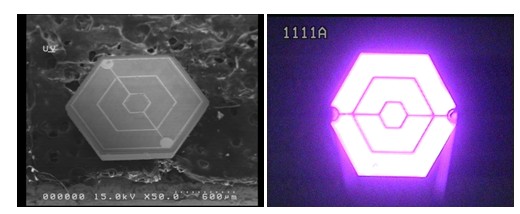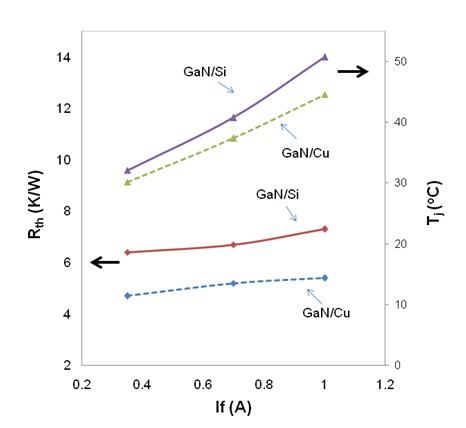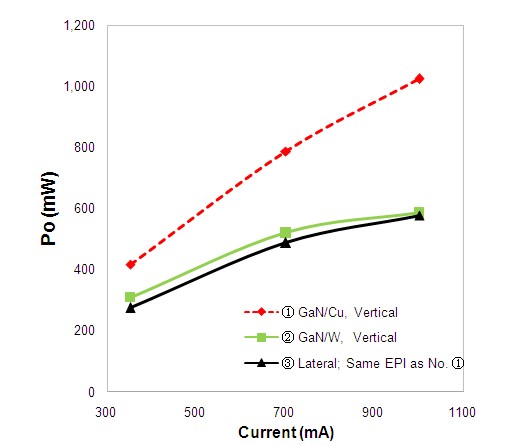Verticle Inc. extends its product line to UV LED. A new hexagonal shaped UV chip is made out of copper substrate enable to drive high current.
Despite its numerous advantages, the main drawback of UV LED is lower optical power due to lower internal quantum efficiency (IQE). Since improving the IQE of UV epitaxial wafers is a long-term prospect, an alternative way to boost UV LED power is to drive more current into the UV-LEDs. However, heat generation is a big issue with high current drive. Moreover, aluminum containing UV epitaxial wafer is more resistive than blue, meaning thermal management of UV LED is more critical than blue. Therefore, one of the main challenges of UV LED is lowering junction temperature.

Fig.1 A SEM image of hexagonal UV-LED chip and UV light emitting from the chip
In order to operate at higher current injection conditions and dissipating heat more efficiently, Verticle’s UV-LED chip is constructed with copper substrate. As shown in Fig.2, Cu base vertical chip’s thermal resistance (Rth) is 2K/W lower than GaN/Si vertical chip. As a result, junction temperature (Tj) of GaN/Cu is lower than GaN/Si. It is noted that the junction temperature difference is 2oC at 350 mA current injection between two chips, however, the difference become larger (6oC) at 1A current injection.
Fig. 3 clearly shows that Verticle’s Cu-base UV-LED chip has higher radiant flux than lateral UV-LED chip fabricated with same epitaxial wafer. Furthermore, Verticle’s UV-LED chip can be driven higher current than other vertical chip constructed with different substrate materials. Verticle’s GaN/Cu UV-LED chip does not saturate over 1A, while GaN/W and GaN/sapphire UV-LED chips start to saturate after 500mA. This means that GaN/Cu chip has higher heat dissipation capability as compared with GaN on other substrates. This shows that Verticle’s Cu-base UV-LED chip has distinct advantages for the applications where high current injection and good thermal properties are required.
Verticle’s hexagonal UV-LED chip’s (45 Mil size) radiant fluxes are measured at 416mW at 350mA current injection, 787mW at 700mA, and 1.025mW at 1A for the 392 nm wavelength, respectively.

Fig. 2 Thermal resistance and junction temperature of GaN/Si and GaN/Cu vertical LEDs as a function of injection current (Ta=25oC).

Fig. 3 Radiant flux* vs. current: 1) GaN/Cu vertical UV-LED, 2) GaN/W vertical UV-LED, and 3) GaN/sapphire lateral UV-LED. * Bare UV-LED chips were attached on 5050 metal lead frame without molding. To eliminate wavelength dependency on radiant flux, 390~395nm UV-LED chips were used.
Additional benefit of Verticle’s hexagonal chip is higher extraction efficiency once it is packaged with circular lens. The reason is that hexagonal chip has near circular beam profile when it is packaged with circular lens, meaning there is less dark spot than rectangular chips. Therefore, HoneycombTM LED is very useful for optic design with circular lens system where near circular beam profile required for various package and module applications. Verticle’s hexagonal UV-LED chip sample is available upon request.
Verticle, Inc is an LED chip company located in the Silicon Valley in CA, US with production facilities in Korea. Verticle specializes in manufacturing vertical type LED chips using a patented Cu substrate and Chemical Chip Separation Technology.














